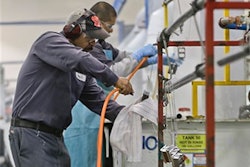LOUISVILLE, Ky. (AP) — Kentucky's farm economy shifted into over-drive as a money maker this year, backed by robust equine, poultry and cattle markets and predictions of record grain yields that are putting total cash receipts on a rapid trajectory toward $6 billion, agricultural economists said Thursday.
The record-breaking projection comes just a year after Kentucky agriculture surpassed $5 billion in cash receipts, or gross sales, for the first time ever in 2012, the University of Kentucky ag economists said. Now, the state's farm economy could add nearly $1 billion in receipts in just one year.
"That's a momentous occasion," said UK ag economist Will Snell. "We went through 10 years where we were trying to get $4 billion."
Farm receipts reached a record $5.3 billion last year as high commodity prices, strong livestock markets and a big influx of crop insurance payments more than offset a severe drought that wilted many crops. The economist said farm receipts could approach or possibly exceed $6 billion this year.
The next round of record-setting receipts won't result in record overall profits for farmers, however.
Snell predicted this year's statewide net farm income — the amount left after expenses — could reach $1.7 billion, up from $1.5 billion in 2012. That would be well below the 2005 record of $2.1 billion in net income, a figure inflated by lump sum tobacco buyout payments, he said.
Looking ahead, the economists said the state's agricultural outlook for 2014 is mixed, but predicted farm cash receipts could still hover around $6 billion or slightly higher.
Livestock markets are expected to remain strong, but grain farmers could face continued lower prices due to increasing global supplies, the economists said.
Other challenges linger, especially for farmers faced with planting new crops amid a grain glut.
"We're going into smaller profit margins," said Cory Walters, a UK economist specializing in grain marketing. "We're going to find out who has the lowest costs, the ones who are really keeping that pencil very sharp, because it's coming."
Finding workers remains a headache for some tobacco, equine and fruits and vegetable farmers, Snell said. A nagging concern for corn farmers is what happens to demand and prices if the federal government cuts the required amount of ethanol in the nation's fuel supply.
Official cash receipts totals for 2013 won't be released until next summer, but the economists pointed to near ideal growing conditions this year along with strong markets for horses, chickens and cattle as reasons for the apparent record pace of farm receipts.
Favorable weather this year produced forecasts of record corn and soybean yields in Kentucky that helped offset lower prices.
Statewide corn production is forecast to reach a record 247 million bushels, up a whopping 138 percent from last year's skimpy production, according to the National Agricultural Statistics Service's field office in Kentucky.
Corn yield is estimated at 173 bushels per acre, up 105 bushels from last year, it said. Soybean production in the state is forecast at a record 80.4 million bushels, up 37 percent from last year. Yield is pegged at 49 bushels an acre — 9 bushels above last year's crop.
Taylor County farmer Chad Sullivan said some of his corn fields yielded just 10 or 15 bushels an acre last year due to the drought. This year, some fields produced more than 200 bushels an acre. His bulging grain yields, along with strong prices for his beef cattle, could make this one of his best years.
"It's probably a little early yet, we've still got crop in the field to harvest, so a lot could still go wrong for us," he said.
Kentucky's tobacco farmers could have their highest valued crop since the 2004 tobacco buyout, as higher production and prices offset lower yields, Snell said. Burley tobacco farmers appear to be fetching about $2.05 to $2.10 per pound for their leaf early in the marketing season, the highest prices since the buyout, he said.
"The tobacco industry is hanging in there," Snell said.
Kentucky is the nation's leading producer of burley tobacco, an ingredient in many cigarettes. Burley production has fallen sharply since the buyout, which ushered in a free-market system to replace Depression-era federal production and price controls. Now, burley is mostly grown under contracts between farmers and tobacco companies.
Meanwhile, the state's signature equine industry continued its momentum in receipts, said UK ag economist Kenny Burdine.
"The increase in sales figures during the fall sales indicate the market is continuing to rebound from post-recession lows," he said. "Continued strong sales and likely increases in stud fees next year should support the market."
The cattle market benefited from lower corn prices, he said. Poultry prices took another jump in 2013 despite increasing supply, he said.
Poultry are expected to account for 21 percent of cash receipts in Kentucky's diversified farm sector this year, followed by horses at 16 percent, soybeans at 15 percent, corn at 13 percent, cattle at 12 percent, tobacco at 7 percent, dairy at 4 percent and other enterprises making up the rest.


















